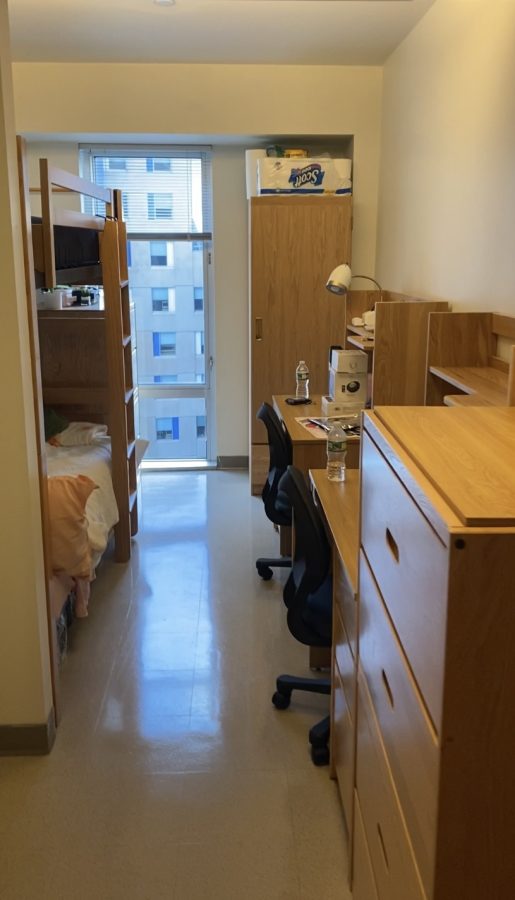Column: Northeastern needs to fix the current housing crisis
Northeastern’s International Village turned a single into a double by inserting a bunk bed, which creates a tight living space.
September 10, 2022
It took six months, until mid-August, for my roommate and me to receive our housing information. This summer was filled with stressful planning and setbacks, as we vied for a dwindling number of dorms. By the time our selection time had arrived, none of our desired options were available. I could not even consider outside housing on short notice because Boston’s apartments are both limited and very expensive in the current seller’s market. With a new school year quickly approaching, one would presume that the simple question of “Where are you living next year?” would have been already answered by the end of the spring semester. Unfortunately, despite Northeastern providing upperclassmen students with a selection number on Feb. 4, my housing situation remained uncertain until a few weeks before the first day of classes.
According to Northeastern’s Housing & Residential Life, “undergraduates who enter as first-year students through fall admission and N.U.in will live in university housing during their first and second years.” Since second-year students must live on campus, students had to choose housing based on randomly assigned lottery numbers ranging from 3,001 to 9,998. Northeastern’s housing website states that students are only assigned through the Placing Assistance With Staff, or PAWS, process if they did not choose their room within their short selection window. But this year, numerous students had no choice but to do the PAWS process. The PAWS program has the university choose the students’ dormitory for the upcoming school year based on a preferences form, where students can indicate their preferable housing situation.
In years past, approximately 25% of students were placed through PAWS. However, today Northeastern no longer has enough capacity for the growing number of undergraduate students. My roommate and I had a 6,000 number, which falls right in the middle of the lottery numbers, yet we had to fill out the PAWS form because no other housing option was available. Furthermore, even though International Village, or IV, was previously made up of single or double rooms, Northeastern decided to push nearly 900 beds into the East Village, or EV, and IV dorms, turning singles into doubles and doubles into triples. This decision might create an uncomfortable living condition as there is not enough physical space, which can lead to students feeling overwhelmed.
Some students hoped that the university heard their previous requests for increased attention to the housing crisis. However, as the new school year approaches, I personally feel none of the prior complaints from my peers or myself have been addressed. The fall housing selection process felt so frustrating and there was nothing students could do but wait for the university to assign housing.
Northeastern tried to acknowledge the current overcrowding crisis by accepting fewer students than ever before. However, downsizing the university is not the answer. Northeastern University’s class of 2025 acceptance rate was 18.38%. For the class of 2026, the acceptance rate dropped down to 6.7%, after receiving a record-breaking 90,000 applicants. Rejecting prospective students for the sake of housing capacity is not a sustainable admissions model for the university. The current housing situation needs to be addressed directly because squeezing returning students and incoming students into small living spaces will likely lead to more frustration from students.
Northeastern is in the process of building another advanced science and engineering research building called EXP on the Boston campus, which accompanies the Interdisciplinary Science and Engineering Complex, or ISEC. The new 350,000-square-foot research building costs $300 million, yet only benefits a small percentage of Northeastern’s student population. According to Northeastern’s 2021 enrollment, the majority of undergraduate full-time students are a part of the D’Amore-McKim School of Business rather than the Colleges of Engineering or Science. Northeastern needs to make a similar investment towards constructing more residence buildings in order to handle the current housing issue.
Since the university has the financial capital to build large facilities, they should redirect these resources towards creating a more comfortable and welcoming housing environment for their students. If they do not act now, Northeastern will only exacerbate the future housing crisis.
Rachel Umansky-Castro is a second-year criminal justice and journalism combined major with a minor in communications. She can be reached at umansky-castro.r@northeastern.edu.






